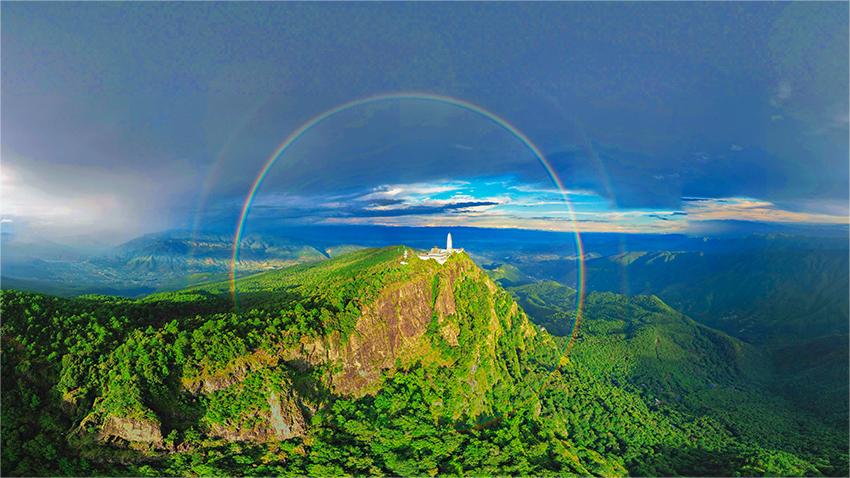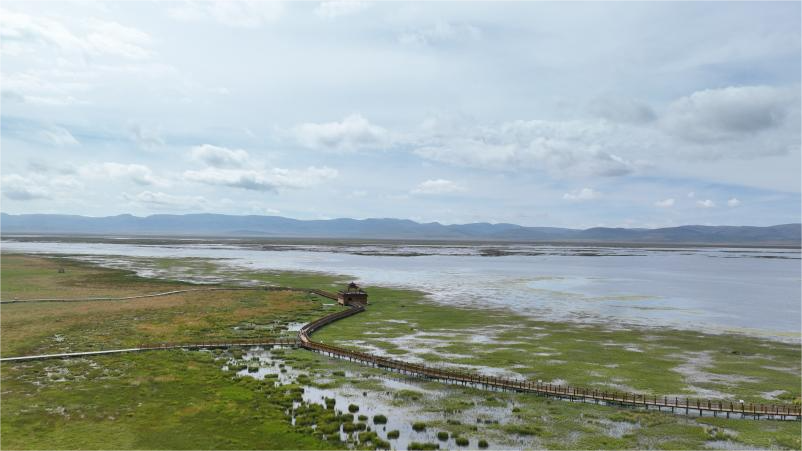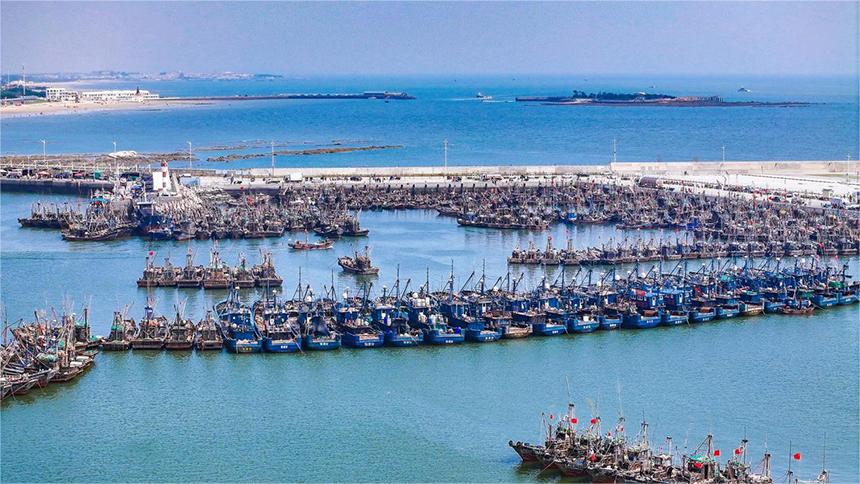Chinese scientific expedition studies climate impact on Qinghai-Xizang Plateau
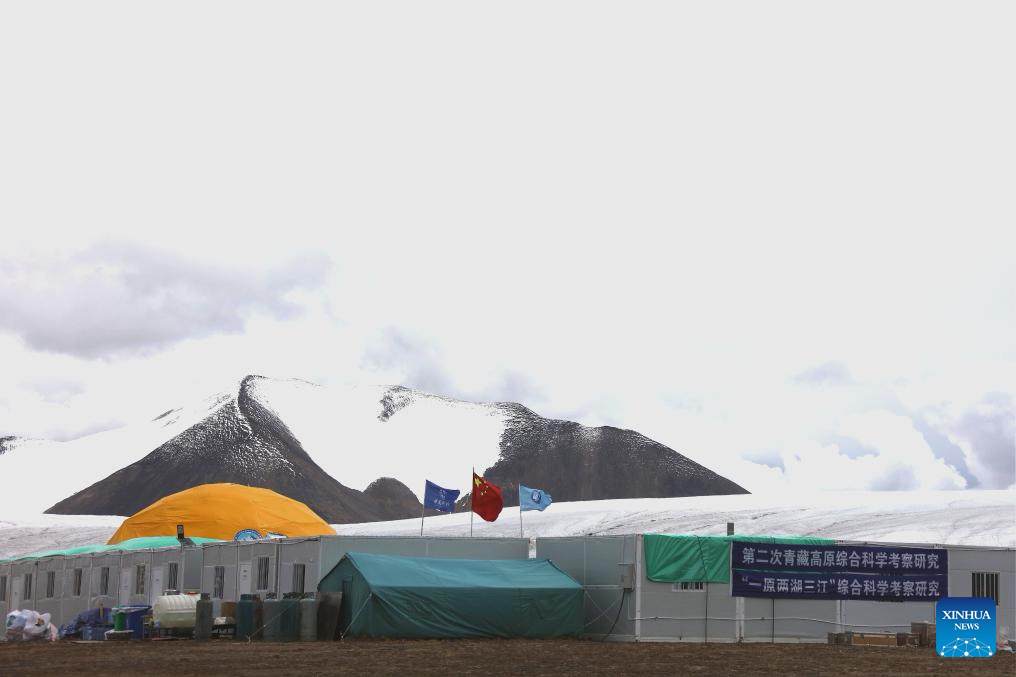
A drone photo shows a Chinese scientific expedition base camp, located 2 to 3 km from the end of No. 10 glacier of the Purog Kangri Glacier in southwest China's Xizang Autonomous Region, Sept. 4, 2024.
China launched a scientific expedition in Lhasa on Aug. 18 to investigate the Qinghai-Xizang Plateau -- known as Asia's "water tower" -- with a target region encompassing "one glacier, two lakes and three rivers."
The region is home to Purog Kangri Glacier, the largest glacier in the world, located in the mid to low-latitude regions, as well as Siling Lake and Namtso Lake, the largest and second-largest lakes in Xizang, respectively. It is also the birthplace of the Yangtze River, Nujiang River and Yarlung Zangbo River.
Over the past 20 years, the climate and environment in the region have experienced dramatic changes, including accelerated glacier retreat and rapid lake expansion. These transformations have affected the structure and function of the regional ecosystem, with significant implications for human survival and development.
This scientific expedition, based on an Earth system science perspective, will identify the characteristics of regional climate and ecological changes and reveal the mechanisms behind these changes. (Xinhua/Liu Shiping)
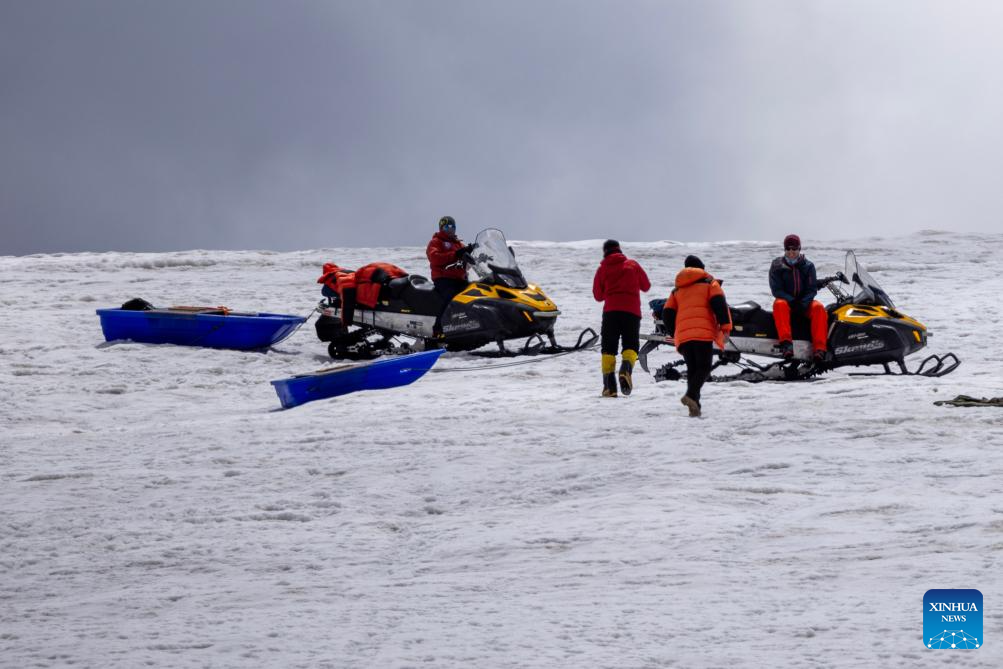
Members of Chinese scientific expedition team prepare to head deep into the Purog Kangri Glacier in southwest China's Xizang Autonomous Region, Sept. 4, 2024.
China launched a scientific expedition in Lhasa on Aug. 18 to investigate the Qinghai-Xizang Plateau -- known as Asia's "water tower" -- with a target region encompassing "one glacier, two lakes and three rivers."
The region is home to Purog Kangri Glacier, the largest glacier in the world, located in the mid to low-latitude regions, as well as Siling Lake and Namtso Lake, the largest and second-largest lakes in Xizang, respectively. It is also the birthplace of the Yangtze River, Nujiang River and Yarlung Zangbo River.
Over the past 20 years, the climate and environment in the region have experienced dramatic changes, including accelerated glacier retreat and rapid lake expansion. These transformations have affected the structure and function of the regional ecosystem, with significant implications for human survival and development.
This scientific expedition, based on an Earth system science perspective, will identify the characteristics of regional climate and ecological changes and reveal the mechanisms behind these changes. (Xinhua/Jiang Fan)

An aerial drone photo shows a Chinese scientific expedition base camp, located 2 to 3 km from the end of No. 10 glacier of the Purog Kangri Glacier in southwest China's Xizang Autonomous Region, Sept. 2, 2024.
China launched a scientific expedition in Lhasa on Aug. 18 to investigate the Qinghai-Xizang Plateau -- known as Asia's "water tower" -- with a target region encompassing "one glacier, two lakes and three rivers."
The region is home to Purog Kangri Glacier, the largest glacier in the world, located in the mid to low-latitude regions, as well as Siling Lake and Namtso Lake, the largest and second-largest lakes in Xizang, respectively. It is also the birthplace of the Yangtze River, Nujiang River and Yarlung Zangbo River.
Over the past 20 years, the climate and environment in the region have experienced dramatic changes, including accelerated glacier retreat and rapid lake expansion. These transformations have affected the structure and function of the regional ecosystem, with significant implications for human survival and development.
This scientific expedition, based on an Earth system science perspective, will identify the characteristics of regional climate and ecological changes and reveal the mechanisms behind these changes. (Xinhua/Liu Shiping)

An aerial drone photo shows the Purog Kangri Glacier in southwest China's Xizang Autonomous Region, Sept. 4, 2024.
China launched a scientific expedition in Lhasa on Aug. 18 to investigate the Qinghai-Xizang Plateau -- known as Asia's "water tower" -- with a target region encompassing "one glacier, two lakes and three rivers."
The region is home to Purog Kangri Glacier, the largest glacier in the world, located in the mid to low-latitude regions, as well as Siling Lake and Namtso Lake, the largest and second-largest lakes in Xizang, respectively. It is also the birthplace of the Yangtze River, Nujiang River and Yarlung Zangbo River.
Over the past 20 years, the climate and environment in the region have experienced dramatic changes, including accelerated glacier retreat and rapid lake expansion. These transformations have affected the structure and function of the regional ecosystem, with significant implications for human survival and development.
This scientific expedition, based on an Earth system science perspective, will identify the characteristics of regional climate and ecological changes and reveal the mechanisms behind these changes. (Xinhua/Liu Shiping)
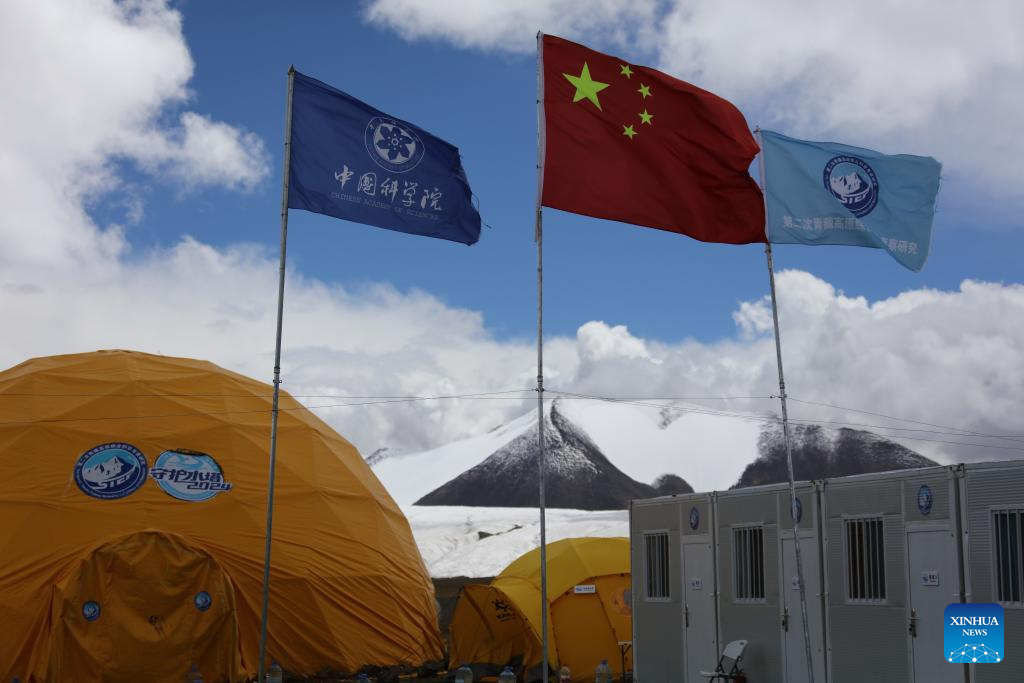
This photo shows a Chinese scientific expedition base camp, located 2 to 3 km from the end of No. 10 glacier of the Purog Kangri Glacier in southwest China's Xizang Autonomous Region, Sept. 4, 2024.
China launched a scientific expedition in Lhasa on Aug. 18 to investigate the Qinghai-Xizang Plateau -- known as Asia's "water tower" -- with a target region encompassing "one glacier, two lakes and three rivers."
The region is home to Purog Kangri Glacier, the largest glacier in the world, located in the mid to low-latitude regions, as well as Siling Lake and Namtso Lake, the largest and second-largest lakes in Xizang, respectively. It is also the birthplace of the Yangtze River, Nujiang River and Yarlung Zangbo River.
Over the past 20 years, the climate and environment in the region have experienced dramatic changes, including accelerated glacier retreat and rapid lake expansion. These transformations have affected the structure and function of the regional ecosystem, with significant implications for human survival and development.
This scientific expedition, based on an Earth system science perspective, will identify the characteristics of regional climate and ecological changes and reveal the mechanisms behind these changes. (Xinhua/Liu Shiping)
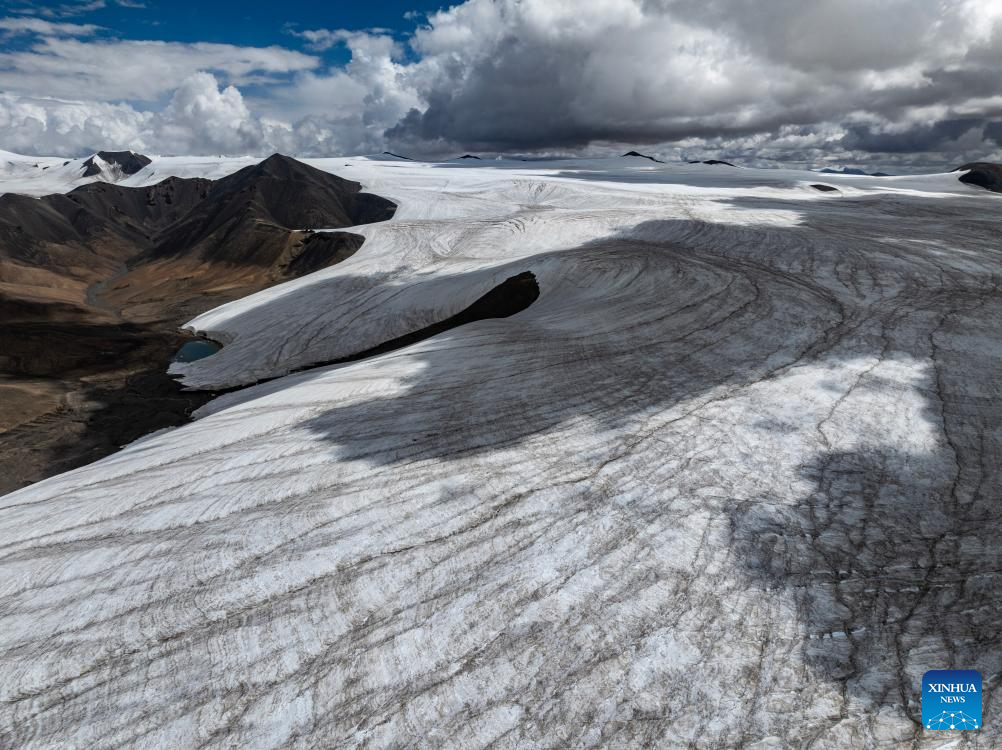
An aerial drone photo shows the Purog Kangri Glacier in southwest China's Xizang Autonomous Region, Sept. 2, 2024.
China launched a scientific expedition in Lhasa on Aug. 18 to investigate the Qinghai-Xizang Plateau -- known as Asia's "water tower" -- with a target region encompassing "one glacier, two lakes and three rivers."
The region is home to Purog Kangri Glacier, the largest glacier in the world, located in the mid to low-latitude regions, as well as Siling Lake and Namtso Lake, the largest and second-largest lakes in Xizang, respectively. It is also the birthplace of the Yangtze River, Nujiang River and Yarlung Zangbo River.
Over the past 20 years, the climate and environment in the region have experienced dramatic changes, including accelerated glacier retreat and rapid lake expansion. These transformations have affected the structure and function of the regional ecosystem, with significant implications for human survival and development.
This scientific expedition, based on an Earth system science perspective, will identify the characteristics of regional climate and ecological changes and reveal the mechanisms behind these changes. (Xinhua/Jiang Fan)
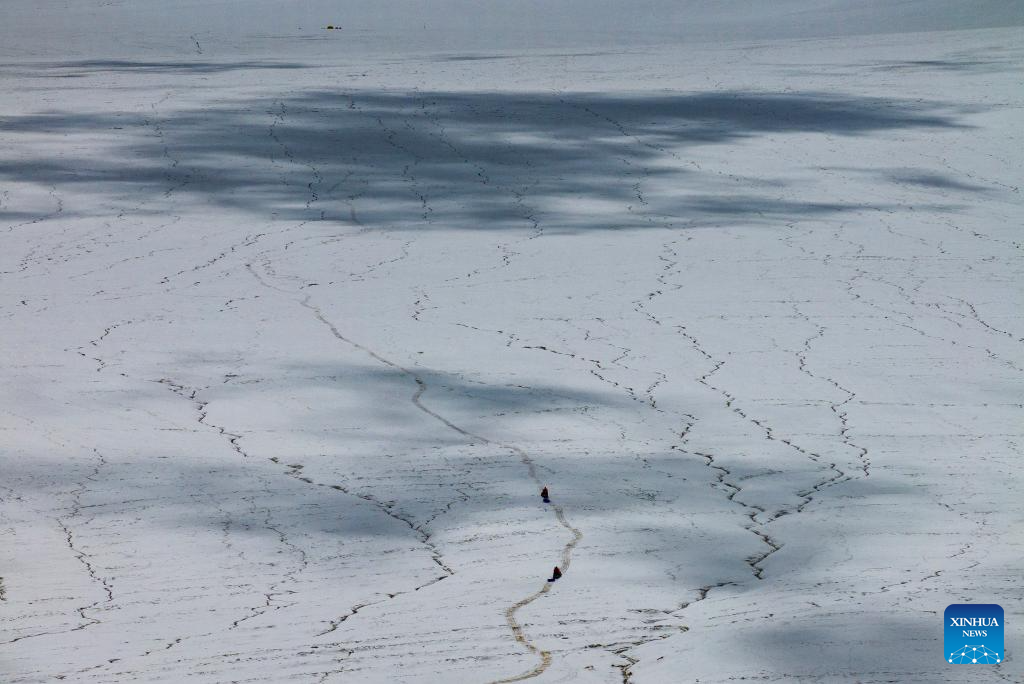
An aerial drone photo shows members of Chinese scientific expedition team heading deep into the Purog Kangri Glacier in southwest China's Xizang Autonomous Region, Sept. 4, 2024.
China launched a scientific expedition in Lhasa on Aug. 18 to investigate the Qinghai-Xizang Plateau -- known as Asia's "water tower" -- with a target region encompassing "one glacier, two lakes and three rivers."
The region is home to Purog Kangri Glacier, the largest glacier in the world, located in the mid to low-latitude regions, as well as Siling Lake and Namtso Lake, the largest and second-largest lakes in Xizang, respectively. It is also the birthplace of the Yangtze River, Nujiang River and Yarlung Zangbo River.
Over the past 20 years, the climate and environment in the region have experienced dramatic changes, including accelerated glacier retreat and rapid lake expansion. These transformations have affected the structure and function of the regional ecosystem, with significant implications for human survival and development.
This scientific expedition, based on an Earth system science perspective, will identify the characteristics of regional climate and ecological changes and reveal the mechanisms behind these changes. (Xinhua/Jiang Fan)
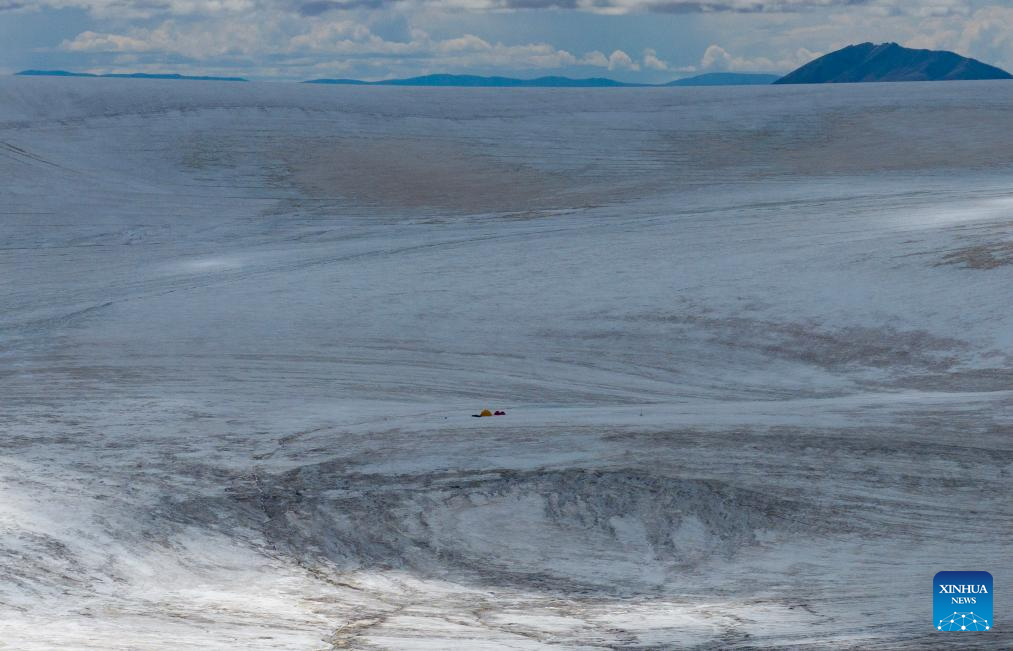
An aerial drone photo shows a temporary base camp of Chinese scientific expedition deep in the Purog Kangri Glacier in southwest China's Xizang Autonomous Region, Sept. 2, 2024.
China launched a scientific expedition in Lhasa on Aug. 18 to investigate the Qinghai-Xizang Plateau -- known as Asia's "water tower" -- with a target region encompassing "one glacier, two lakes and three rivers."
The region is home to Purog Kangri Glacier, the largest glacier in the world, located in the mid to low-latitude regions, as well as Siling Lake and Namtso Lake, the largest and second-largest lakes in Xizang, respectively. It is also the birthplace of the Yangtze River, Nujiang River and Yarlung Zangbo River.
Over the past 20 years, the climate and environment in the region have experienced dramatic changes, including accelerated glacier retreat and rapid lake expansion. These transformations have affected the structure and function of the regional ecosystem, with significant implications for human survival and development.
This scientific expedition, based on an Earth system science perspective, will identify the characteristics of regional climate and ecological changes and reveal the mechanisms behind these changes. (Xinhua/Jiang Fan)
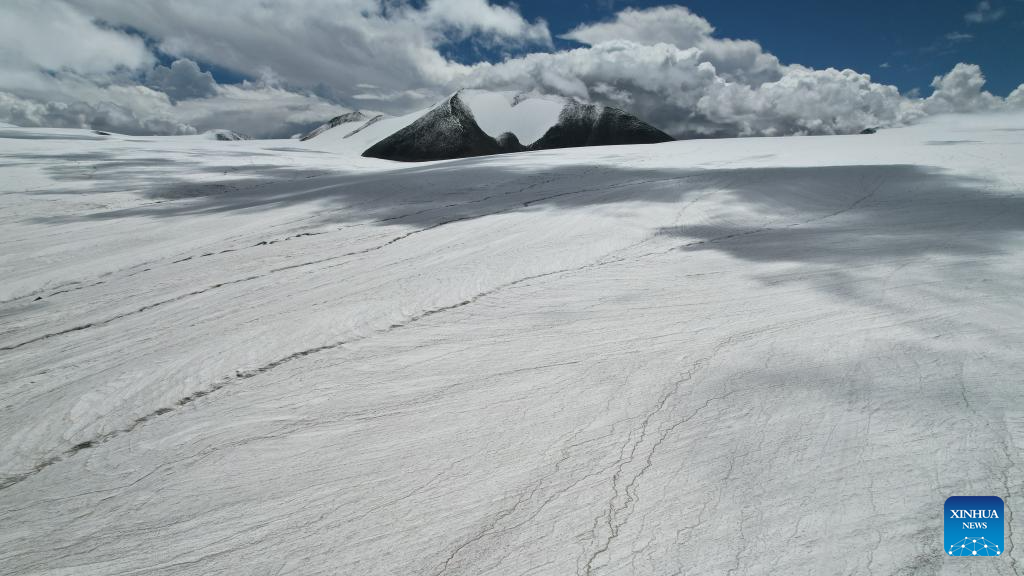
An aerial drone photo shows the Purog Kangri Glacier in southwest China's Xizang Autonomous Region, Sept. 4, 2024.
China launched a scientific expedition in Lhasa on Aug. 18 to investigate the Qinghai-Xizang Plateau -- known as Asia's "water tower" -- with a target region encompassing "one glacier, two lakes and three rivers."
The region is home to Purog Kangri Glacier, the largest glacier in the world, located in the mid to low-latitude regions, as well as Siling Lake and Namtso Lake, the largest and second-largest lakes in Xizang, respectively. It is also the birthplace of the Yangtze River, Nujiang River and Yarlung Zangbo River.
Over the past 20 years, the climate and environment in the region have experienced dramatic changes, including accelerated glacier retreat and rapid lake expansion. These transformations have affected the structure and function of the regional ecosystem, with significant implications for human survival and development.
This scientific expedition, based on an Earth system science perspective, will identify the characteristics of regional climate and ecological changes and reveal the mechanisms behind these changes. (Xinhua/Liu Shiping)

An aerial drone photo shows the Purog Kangri Glacier in southwest China's Xizang Autonomous Region, Sept. 4, 2024.
China launched a scientific expedition in Lhasa on Aug. 18 to investigate the Qinghai-Xizang Plateau -- known as Asia's "water tower" -- with a target region encompassing "one glacier, two lakes and three rivers."
The region is home to Purog Kangri Glacier, the largest glacier in the world, located in the mid to low-latitude regions, as well as Siling Lake and Namtso Lake, the largest and second-largest lakes in Xizang, respectively. It is also the birthplace of the Yangtze River, Nujiang River and Yarlung Zangbo River.
Over the past 20 years, the climate and environment in the region have experienced dramatic changes, including accelerated glacier retreat and rapid lake expansion. These transformations have affected the structure and function of the regional ecosystem, with significant implications for human survival and development.
This scientific expedition, based on an Earth system science perspective, will identify the characteristics of regional climate and ecological changes and reveal the mechanisms behind these changes. (Xinhua/Liu Shiping)
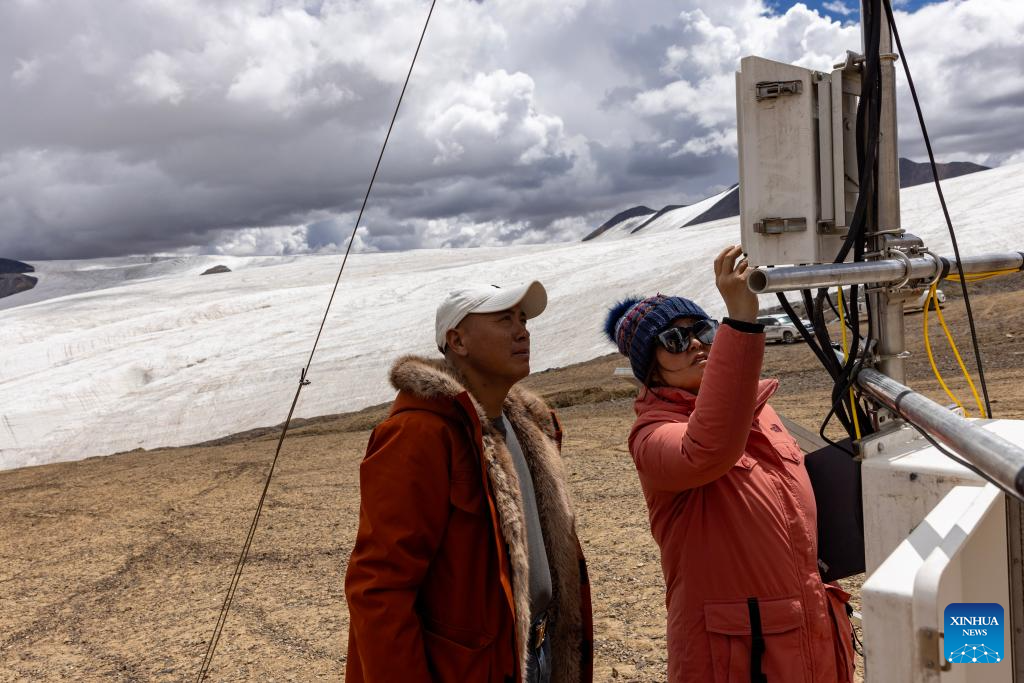
Researcher Niu Xiaowei (R) adjusts an air sampling device at the end of the Purog Kangri Glacier in southwest China's Xizang Autonomous Region, Sept. 2, 2024.
China launched a scientific expedition in Lhasa on Aug. 18 to investigate the Qinghai-Xizang Plateau -- known as Asia's "water tower" -- with a target region encompassing "one glacier, two lakes and three rivers."
The region is home to Purog Kangri Glacier, the largest glacier in the world, located in the mid to low-latitude regions, as well as Siling Lake and Namtso Lake, the largest and second-largest lakes in Xizang, respectively. It is also the birthplace of the Yangtze River, Nujiang River and Yarlung Zangbo River.
Over the past 20 years, the climate and environment in the region have experienced dramatic changes, including accelerated glacier retreat and rapid lake expansion. These transformations have affected the structure and function of the regional ecosystem, with significant implications for human survival and development.
This scientific expedition, based on an Earth system science perspective, will identify the characteristics of regional climate and ecological changes and reveal the mechanisms behind these changes. (Xinhua/Jiang Fan)
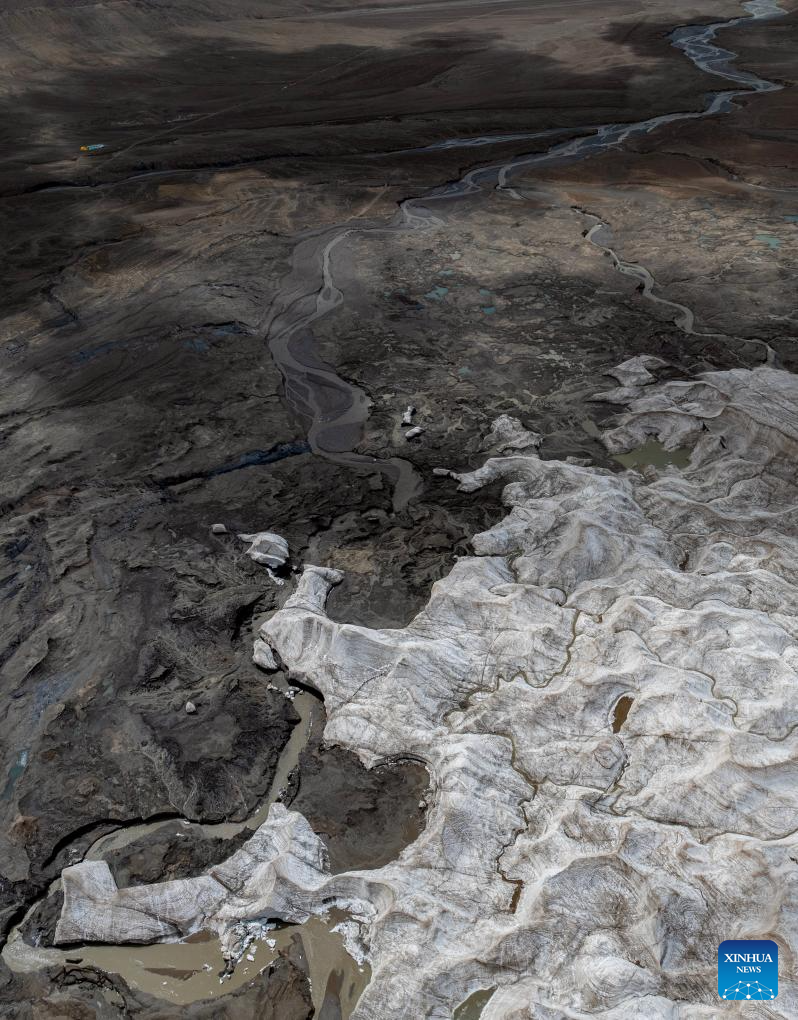
This stitched aerial drone photo shows a Chinese scientific expedition base camp (L, upper) on the Purog Kangri Glacier in southwest China's Xizang Autonomous Region, Sept. 4, 2024.
China launched a scientific expedition in Lhasa on Aug. 18 to investigate the Qinghai-Xizang Plateau -- known as Asia's "water tower" -- with a target region encompassing "one glacier, two lakes and three rivers."
The region is home to Purog Kangri Glacier, the largest glacier in the world, located in the mid to low-latitude regions, as well as Siling Lake and Namtso Lake, the largest and second-largest lakes in Xizang, respectively. It is also the birthplace of the Yangtze River, Nujiang River and Yarlung Zangbo River.
Over the past 20 years, the climate and environment in the region have experienced dramatic changes, including accelerated glacier retreat and rapid lake expansion. These transformations have affected the structure and function of the regional ecosystem, with significant implications for human survival and development.
This scientific expedition, based on an Earth system science perspective, will identify the characteristics of regional climate and ecological changes and reveal the mechanisms behind these changes. (Xinhua/Jiang Fan)

An aerial drone photo shows the Purog Kangri Glacier in southwest China's Xizang Autonomous Region, Sept. 2, 2024.
China launched a scientific expedition in Lhasa on Aug. 18 to investigate the Qinghai-Xizang Plateau -- known as Asia's "water tower" -- with a target region encompassing "one glacier, two lakes and three rivers."
The region is home to Purog Kangri Glacier, the largest glacier in the world, located in the mid to low-latitude regions, as well as Siling Lake and Namtso Lake, the largest and second-largest lakes in Xizang, respectively. It is also the birthplace of the Yangtze River, Nujiang River and Yarlung Zangbo River.
Over the past 20 years, the climate and environment in the region have experienced dramatic changes, including accelerated glacier retreat and rapid lake expansion. These transformations have affected the structure and function of the regional ecosystem, with significant implications for human survival and development.
This scientific expedition, based on an Earth system science perspective, will identify the characteristics of regional climate and ecological changes and reveal the mechanisms behind these changes. (Xinhua/Jiang Fan)
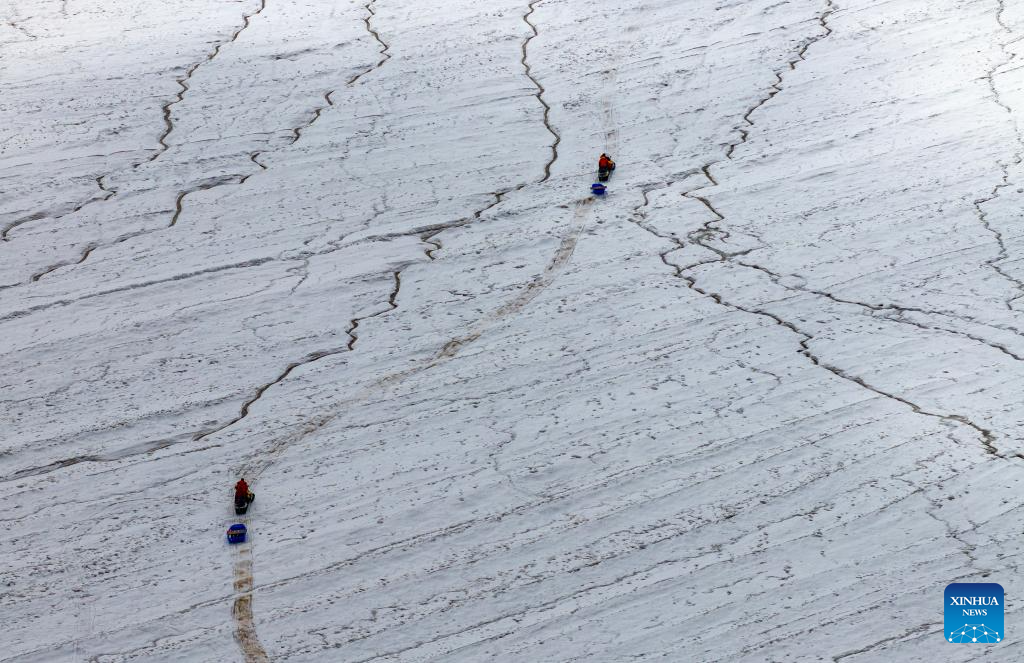
An aerial drone photo shows members of Chinese scientific expedition team heading deep into the Purog Kangri Glacier in southwest China's Xizang Autonomous Region, Sept. 4, 2024.
China launched a scientific expedition in Lhasa on Aug. 18 to investigate the Qinghai-Xizang Plateau -- known as Asia's "water tower" -- with a target region encompassing "one glacier, two lakes and three rivers."
The region is home to Purog Kangri Glacier, the largest glacier in the world, located in the mid to low-latitude regions, as well as Siling Lake and Namtso Lake, the largest and second-largest lakes in Xizang, respectively. It is also the birthplace of the Yangtze River, Nujiang River and Yarlung Zangbo River.
Over the past 20 years, the climate and environment in the region have experienced dramatic changes, including accelerated glacier retreat and rapid lake expansion. These transformations have affected the structure and function of the regional ecosystem, with significant implications for human survival and development.
This scientific expedition, based on an Earth system science perspective, will identify the characteristics of regional climate and ecological changes and reveal the mechanisms behind these changes. (Xinhua/Jiang Fan)
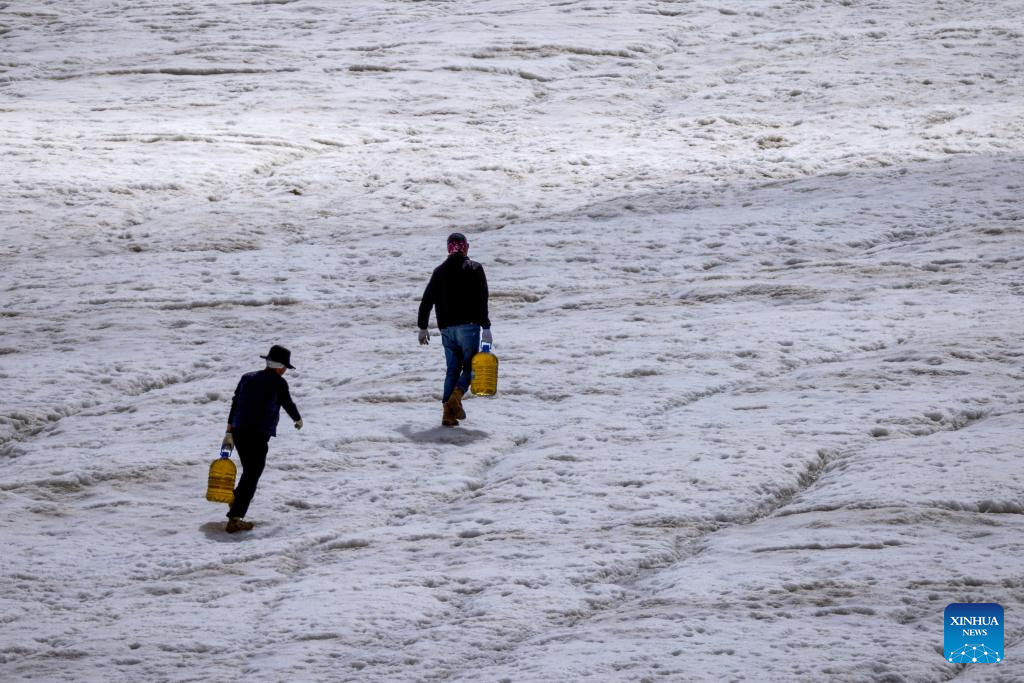
Members of Chinese scientific expedition team carry fuels for snow bikes in the Purog Kangri Glacier in southwest China's Xizang Autonomous Region, Sept. 4, 2024.
China launched a scientific expedition in Lhasa on Aug. 18 to investigate the Qinghai-Xizang Plateau -- known as Asia's "water tower" -- with a target region encompassing "one glacier, two lakes and three rivers."
The region is home to Purog Kangri Glacier, the largest glacier in the world, located in the mid to low-latitude regions, as well as Siling Lake and Namtso Lake, the largest and second-largest lakes in Xizang, respectively. It is also the birthplace of the Yangtze River, Nujiang River and Yarlung Zangbo River.
Over the past 20 years, the climate and environment in the region have experienced dramatic changes, including accelerated glacier retreat and rapid lake expansion. These transformations have affected the structure and function of the regional ecosystem, with significant implications for human survival and development.
This scientific expedition, based on an Earth system science perspective, will identify the characteristics of regional climate and ecological changes and reveal the mechanisms behind these changes. (Xinhua/Jiang Fan)
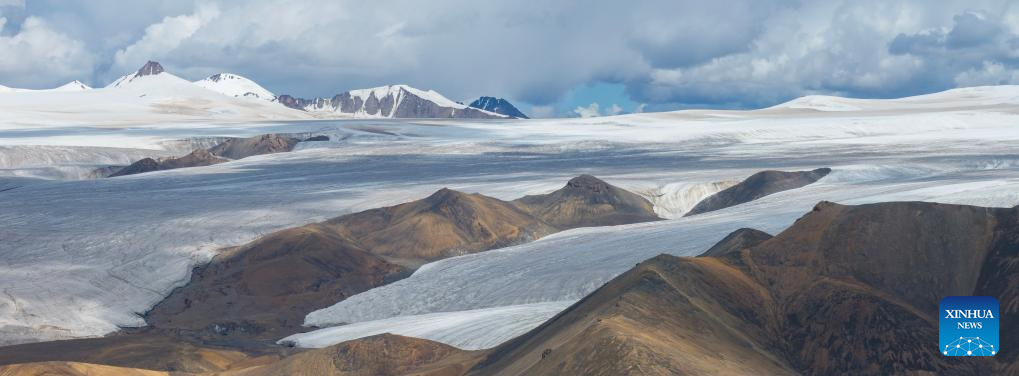
This stitched aerial drone photo shows the Purog Kangri Glacier in southwest China's Xizang Autonomous Region, Sept. 4, 2024.
China launched a scientific expedition in Lhasa on Aug. 18 to investigate the Qinghai-Xizang Plateau -- known as Asia's "water tower" -- with a target region encompassing "one glacier, two lakes and three rivers."
The region is home to Purog Kangri Glacier, the largest glacier in the world, located in the mid to low-latitude regions, as well as Siling Lake and Namtso Lake, the largest and second-largest lakes in Xizang, respectively. It is also the birthplace of the Yangtze River, Nujiang River and Yarlung Zangbo River.
Over the past 20 years, the climate and environment in the region have experienced dramatic changes, including accelerated glacier retreat and rapid lake expansion. These transformations have affected the structure and function of the regional ecosystem, with significant implications for human survival and development.
This scientific expedition, based on an Earth system science perspective, will identify the characteristics of regional climate and ecological changes and reveal the mechanisms behind these changes. (Xinhua/Jiang Fan)

An aerial drone photo shows the Purog Kangri Glacier in southwest China's Xizang Autonomous Region, Sept. 2, 2024.
China launched a scientific expedition in Lhasa on Aug. 18 to investigate the Qinghai-Xizang Plateau -- known as Asia's "water tower" -- with a target region encompassing "one glacier, two lakes and three rivers."
The region is home to Purog Kangri Glacier, the largest glacier in the world, located in the mid to low-latitude regions, as well as Siling Lake and Namtso Lake, the largest and second-largest lakes in Xizang, respectively. It is also the birthplace of the Yangtze River, Nujiang River and Yarlung Zangbo River.
Over the past 20 years, the climate and environment in the region have experienced dramatic changes, including accelerated glacier retreat and rapid lake expansion. These transformations have affected the structure and function of the regional ecosystem, with significant implications for human survival and development.
This scientific expedition, based on an Earth system science perspective, will identify the characteristics of regional climate and ecological changes and reveal the mechanisms behind these changes. (Xinhua/Liu Shiping)
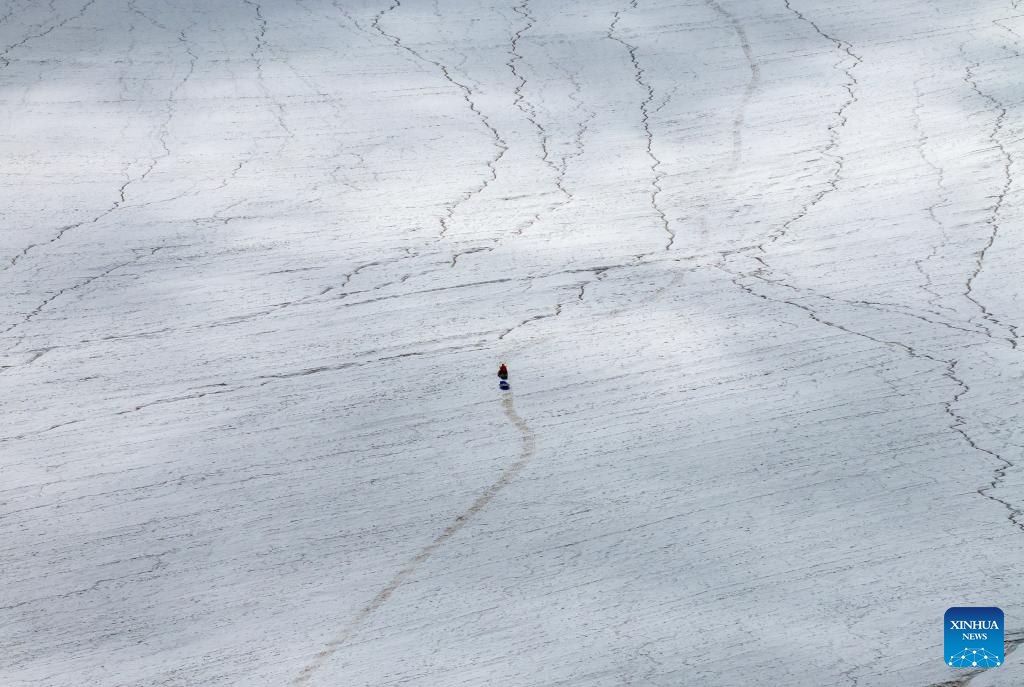
An aerial drone photo shows a member of Chinese scientific expedition team heading deep into the Purog Kangri Glacier in southwest China's Xizang Autonomous Region, Sept. 4, 2024.
China launched a scientific expedition in Lhasa on Aug. 18 to investigate the Qinghai-Xizang Plateau -- known as Asia's "water tower" -- with a target region encompassing "one glacier, two lakes and three rivers."
The region is home to Purog Kangri Glacier, the largest glacier in the world, located in the mid to low-latitude regions, as well as Siling Lake and Namtso Lake, the largest and second-largest lakes in Xizang, respectively. It is also the birthplace of the Yangtze River, Nujiang River and Yarlung Zangbo River.
Over the past 20 years, the climate and environment in the region have experienced dramatic changes, including accelerated glacier retreat and rapid lake expansion. These transformations have affected the structure and function of the regional ecosystem, with significant implications for human survival and development.
This scientific expedition, based on an Earth system science perspective, will identify the characteristics of regional climate and ecological changes and reveal the mechanisms behind these changes. (Xinhua/Jiang Fan)
Photos
Related Stories
- Disastrous rainstorms drench provinces across China
- Rainfall continues to batter southern China
- Authorities take actions to respond to droughts caused by heat waves in central, northern China
- China’s national average temperature in May hit a record high in history since 1961
- High temperature expected in southern parts but prolonged extreme heat wave less likely to happen in China this summer: meteorologists
- Climate leaders stress U.S.-China sub-national cooperation
Copyright © 2024 People's Daily Online. All Rights Reserved.






